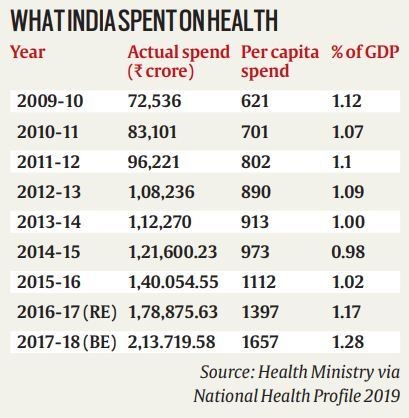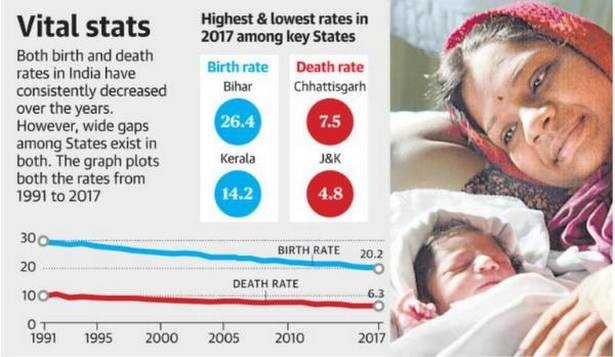PREVIOUS
National Health Profile - 2019
November 6 , 2019
1974 days
4558
0
- The Union Health Minister Harsh Vardhan released the 14th edition of NHP.
- The NHP provides a comprehensive framework on the socio-economic health status and the status of demographic and health resources in the country.
- The National Health Profile is prepared by the Central Bureau of Health Intelligence (CBHI).
- It was first published in 2005.
Indicators:
- The profile is based on three important broad indicators. For example,
- Demographic indicators – Population and Vital statistics.
- Socio-economic indicators – Employment, Education, Housing and Amenities and Sanitation and Drinking Water.
- Health status indicators – The prevalence of common communicable and non-communicable diseases.
Key Findings
- The country’s public expenditure on health continues to remain the lowest globally at 1.28% of the GDP (2017-18 Budget Estimate).
- In comparison, nations classified as Lower Income Countries by the World Bank spent 1.57 per cent of their GDP on health that year.
- It seems that it is an uphill task to meet the target of 2.5% of the GDP by 2025.
- The global average is about 6 per cent.
- India’s health budget for 2019-20 was less than 63,000 crores.
- The comparative data shows that among the 10 South East Asia Region (SEAR) countries India at 0.93% of the GDP was above only Bangladesh at 0.42%.
- At less than USD 16, country’s per capita expenditure on health is also abysmally low compared to most other SEAR nations.
- The report notes that diabetes and hypertension rate are high among Indians while dengue and chikungunya are a cause of great concern to public health.

- Life expectancy in India has increased from 49.7 years in 1970-75 to 68.7 years in 2012-16.
- For the same period, the life expectancy for females is 70.2 years and 67.4 years for males.
- According to the survey, the highest population density of 11,320 people per square kilometre was reported by the National Capital Territory of Delhi (NCT) whereas Arunachal Pradesh reported the lowest population density of 17.
- Of the total estimated population of 2016, the survey notes that
- 27% were below the age of 14 years
- 64.7% of the population were in the age group of 15-59 years
- 8.5% population were in the age group of 60-85 plus years.
- There has been consistent decrease in the birth rate, death rate and natural growth rate in India since 1991 to 2017.
- As on 2017, India has registered birth rate of 20.2 per population of 1,000 and death rate of 6.3 while the natural growth rate was 13.9 per population of 1,000.
- The birth rate in rural areas was higher than in the urban.
- Similarly, the death rate and natural growth rate were also higher in rural areas as compared to the urban.
- The population, however, continues to grow, as the decline in the birth rate is not as rapid as the decline in the death rate.
- As per the NHP, sex ratio (number of females per 1,000 males) in the country has improved from 933 in 2001 to 943 in 2011.
- In rural areas the sex ratio has increased from 946 to 949.
- Kerala has recorded the highest sex ratio in respect of total population (1,084), rural population (1,078) and urban (1,091).
- The lowest sex ratio in rural areas has been recorded in Chandigarh (690).
- The infant mortality rate (IMR) has declined considerably (33 per 1,000 live births in 2016), however differentials of rural (37) and urban (23) are still high.
- The Total Fertility Rate (TFR) for the country was 2.3 whereas in rural areas it was 2.5 and 1.8 in urban areas.
- The TFR (average number of children that will be born to a woman during her lifetime) in 12 States has fallen below two children per woman and nine States have reached replacement levels of 2.1 and above.
- Delhi, Tamil Nadu and West Bengal have the lowest fertility rate among other States.
- On the health status indicators, the survey finds that on communicable diseases, in 2018, maximum number of cases and deaths due to malaria have been reported in Chhattisgarh (77,140 cases and 26 deaths).
- The total number of disabled persons in India is 2.68 crore.
- Accidental Injuries:13 lakh people lost their life due to accidental injuries in 2015
- Suicide: Suicide rates are increasing significantly among young adults. Maximum number of suicide cases (44,593) is reported between the age group 30-45 years. 1.33 lakh people died by suicide.
- Snake bite: The total number of cases and deaths due to snake bite are 1.64 lakh and 885, respectively, in 2018.

ó ó ó ó ó ó ó ó ó ó
Leave a Reply
Your Comment is awaiting moderation.


